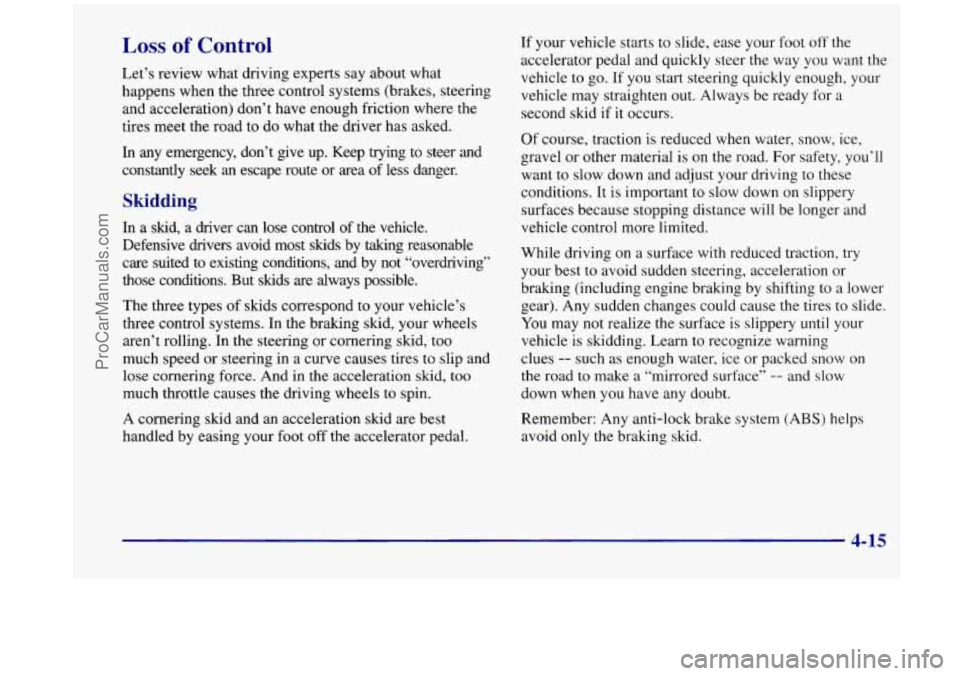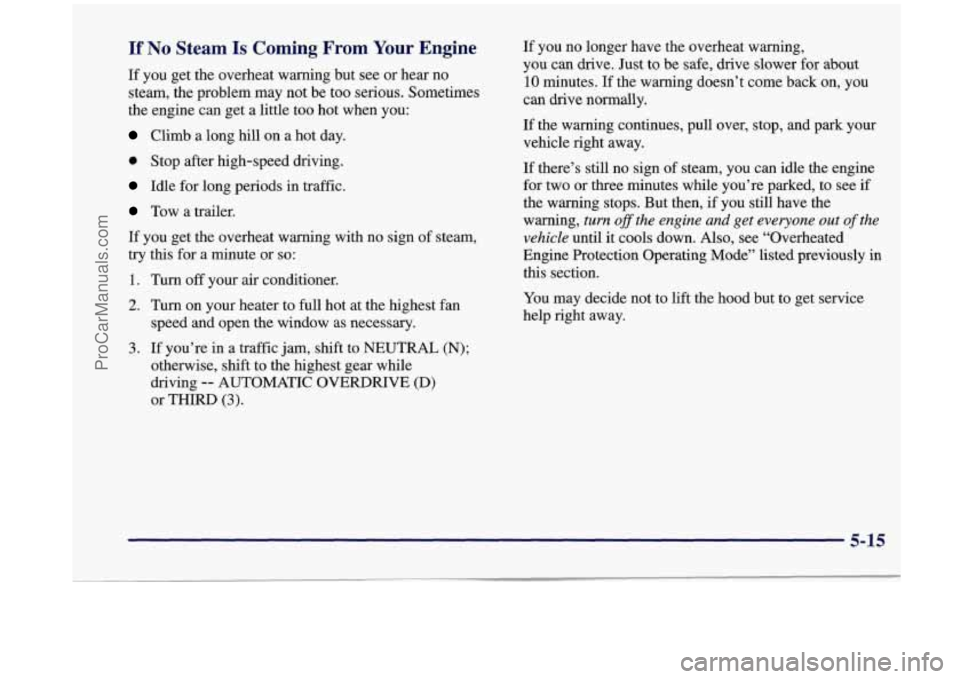Page 247 of 444

Loss of Control
Let’s review what driving experts say about what
happens when the three control systems (brakes, steering
and acceleration) don’t have enough friction where the
tires meet the road to do what the driver has asked.
In any emergency, don’t give up. Keep trying to steer and
constantly seek an escape route or area of less danger.
In
a skid, a driver can lose control of the vehicle.
Defensive drivers avoid most skids by taking reasonable
care suited to existing conditions, and by not “overdriving”
those conditions. But skids are always possible.
The three types
of skids correspond to your vehicle’s
three control systems. In the braking skid, your wheels
aren’t rolling. In the steering or cornering skid, too
much speed or steering in a curve causes tires to slip and
lose cornering force. And in the acceleration skid,
too
much throttle causes the driving wheels to spin.
A cornering skid and an acceleration skid are best
handled by easing your foot off the accelerator pedal.
If your vehicle starts to slide, ease your foot off the
accelerator pedal and quickly steer
the way you want the
vehicle to go.
If you start steering quickly enough, your
vehicle may straighten out. Always be ready for a
second skid if it occurs.
Of course, traction is reduced when water, snow, ice,
gravel or other material is on the road. For safety, you’ll
want to slow down and adjust your driving to these
conditions. It is important to slow down on slippery
surfaces because stopping distance will be longer and
vehicle control more limited.
While driving on a surface with reduced traction, try
your best to avoid sudden steering, acceleration or
braking (including engine braking by shifting to a lower
gear). Any sudden changes could cause the tires to slide.
You may not realize
the surface is slippery until your
vehicle is skidding. Learn to recognize warning
clues
-- such as enough water, ice or packed snow on
the road to make a “mirrored surface”
-- and slow
down when you have any doubt.
Remember: Any anti-lock brake system
(ABS) helps
avoid only the braking skid.
4-15
ProCarManuals.com
Page 253 of 444
City Driving Here are ways to increase your safety in city driving:
0
0
0
One of the biggest problems with city streets is the
amount of traffic on them. You’ll want
to watch out for
what the other drivers are doing and pay attention to
traffic signals. Know
the best way to get to where
you are
going. Get a city map and plan your trip into an
unknown part
of the city just as you would for a
cross-country trip.
Try to use the freeways that rim and crisscross most
large cities. You’ll save time and energy. (See the
next part, “Freeway Driving.”)
Treat a green light as a warning signal.
A traffic
light is there because the corner is busy enough to
need it. When a light turns green, and just before you
start to move, check both ways
for vehicles that have
not cleared the intersection or may be running the
red light.
4-21
ProCarManuals.com
Page 258 of 444
I
Winter Driving Include an ice scraper, a small brush or broom, a supply
of windshield washer fluid, a rag, some winter outer
clothing,
a small shovel, a flashlight, a red cloth and
reflective warning triangles. And, if you will be driving
under severe conditions, include
a small bag of sand, a
piece of old carpet or a couple
of burlap bags to help
provide traction. Be sure you properly secure these
items in your vehicle.
Driving on Snow or Ice
Here are some tips for winter driving:
0 Have your vehicle in good shape for winter. Most
of the time, those places where your tires
meet the
road probably have good traction.
However,
if there is snow or ice between your tires and
the road, you can have a very slippery situation. You’ll
have
a lot less traction or “grip” and will need to be
very careful.
I You may want to put winter emergency supplies in
your vehicle.
ProCarManuals.com
Page 275 of 444
Section 5 Problems on the Road
Here you’ll find what to do about some problems that can occur on the road.
5-2
5-2
5-3
5-7
5- 13
5-24 Hazard Warning
Flashers
Other Warning Devices
Jump Starting Towing Your Vehicle
Engine Overheating If a Tire Goes Flat
5-24 Air Inflator (Option)
5-24 Changing a Flat Tire
5-34 Compact Spare Tire
5-35 If You’re Stuck: In Sand,
Mud, Ice or Snow
ProCarManuals.com
Page 276 of 444
Hazard Warning Flashers
Your hazard warning flashers let you warn others. They
also let police know you have a problem. Your front and
rear turn signal lamps will flash on and off. Your
hazard warning
flashers button is on top of
the steering column. Press
the button in to turn on
your flashers.
Your ha,,,, warning flashers work no matter what
position your key
is in, and even if the key isn’t in.
To turn off the flashers, push the button down and it will
pop back up by itself.
When the hazard warning flashers are on, your turn
signals won’t work.
Other Warning Devices
If you carry reflective triangles, you can set one up at
the side
of the road about 300 feet (100 m) behind
your vehicle.
5-2
ProCarManuals.com
Page 281 of 444
11. Remove the cables in reverse order to prevent
electrical shorting. Take care that they don’t touch
each other or any other metal.
A. Heavy Metal Engine Part
B. Good Battery
C. Dead Battery
Towing Your Vehicle
Try to have a GM dealer or a professional towing
service tow your vehicle. They can provide the right
equipment and
know how to tow it without damage. See
“Roadside Assistance” in the Index.
If your vehicle has been changed or modified since
it
was factory-new by adding aftermarket items like fog
lamps, aero skirting, or special tires and wheels, these
things can be damaged during towing.
Before you do anything, turn
on the hazard
warning flashers.
When you call, tell the towing service:
That your vehicle has front-wheel drive.
That your vehicle cannot be towed from the front or
rear with sling-type equipment.
0 The make, model and year of your vehicle.
Whether you can still move the shift lever.
0 If there was an accident, what was damaged.
ProCarManuals.com
Page 289 of 444

If No Steam Is Coming From Your Engine
If you get the overheat warning but see or hear no
steam, the problem may not be too serious. Sometimes
the engine can get a little too hot when you:
Climb a long hill on a hot day.
0 Stop after high-speed driving.
Idle for long periods in traffic.
Tow a trailer.
If you get the overheat warning with no sign of steam,
try this for a minute or
so:
1. Turn off your air conditioner.
2. Turn on your heater to full hot at the highest fan
speed and open the window as necessary.
3. If you’re in a traffic jam, shift to NEUTRAL (N);
otherwise, shift to the highest gear while
driving
-- AUTOMATIC OVERDRIVE (D)
or THIRD (3).
If you no longer have the overheat warning,
you can drive. Just to be safe, drive slower for about
10 minutes. If the warning doesn’t come back on, you
can drive normally.
If the warning continues, pull over, stop, and park your
vehicle right away.
If there’s still no sign of steam, you can idle the engine
for two or three minutes while you’re parked, to see
if
the warning stops. But then, if you still have the
warning,
turn off the engine and get everyone out of the
vehicle
until it cools down. Also, see “Overheated
Engine Protection Operating Mode” listed previously in
this section.
You may decide not to lift the hood but to get service
help right away.
5-15
ProCarManuals.com
Page 292 of 444
IN:
How to Add Coolant to the Coolant
Recovery
Tank
If you haven’t found a problem yet, but the coolant
level isn’t at or above the FULL COLD mark, add a
50/50 mixture of clean water (preferably distilled) and
DEX-COOL@ engine coolant at the coolant recovery
tank.
(See “Engine Coolant” in the Index for
more information.)
- -
Adding only plain water to your cooling system
can be dangerous. Plain water, or some other
liquid like alcohol, can boil before the proper
coolant mixture will. Your vehicle’s coolant
warning system is set for the proper coolant
mixture. With plain water or the wrong mixture,
your engine could get too hot but you wouldn’t
get the overheat warning. Your engine could
catch fire and you or others could be burned.
Use
a 50/50 mixture of clean water and
DEX-COOL@ coolant.
NOTICE:
In cold weather, water can freeze and crack the
engine, radiator, heater core and other parts.
Use the recommended coolant and the proper
coolant mixture.
5-18
ProCarManuals.com